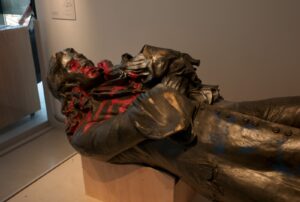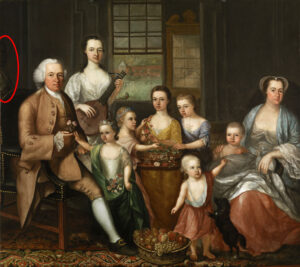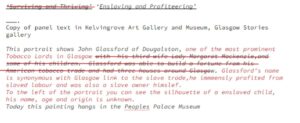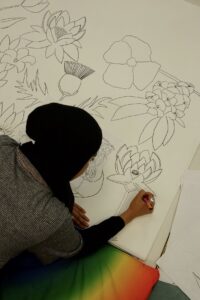Decolonising museums by exhibiting accountability: a changemakers’ concept
This blog by Kulsum Shabbir is the second in a set of commissioned blogs from the Our Shared Cultural Heritage(OSCH) Changemakers program . These blogs were commissioned to share their thoughts and reflections in the light of the Empire, Slavery & Scotland’s Museums (ESSM) recommendations to the Scottish Government in June 2022.
What does it mean to decolonise?
Decolonisation is about reclaiming a white-washed narrative that has been accepted for too long in museums and galleries. By decentring white people in history, we have the opportunity to bring the stories of people of colour (POC) to the forefront and fully appreciate what truly happened.
An integral part of decolonising museums and galleries is accountability. In acknowledging their complicity in the glorification of the British Empire and making an effort to correct this, museums and galleries can take a small step towards being anti-racist.
Who are the changemakers?
The OSCH changemakers are a group of young people from 18-25 years old who work with Kelvingrove Art Gallery and Glasgow Museums to explore and design ways to ensure POC narratives are accurately and fairly represented when museums and galleries explore the legacies of empire and slavery.
Our group’s goal is to explore decolonisation with other young POC in order to implement this in museums and galleries. This takes shape in many different projects, both creative and academic. For example, the lascar research project which entailed both a presentation at an academic seminar, as well as a zine featuring original poetry and artwork.
The work of the changemakers corresponds with the third ESSM Steering Group recommendation:
Museums should involve the people of Scotland in shaping their work through co-production, to promote cultural democracy and participation for all.
Through countless discussions, the changemakers defined decolonisation as:
- Accountability
- Reclamation of POC narratives
- Permanent displays featuring POC/ a dedicated space for these displays
- Acknowledging the white-washing of colonial history
- De-centring white people in history
Exhibiting accountability, what does this mean?
The concept of re-exhibition was born as a result of many conversations about what museums can do moving forward to hold themselves accountable.
During our time at Kelvingrove Art Gallery and Museum, the changemakers noticed that the little representation that was present in the exhibits on Empire, slavery, and its legacies often minimised the atrocities it caused.
For example, the few exhibits that made reference to slavery did not include depictions of POC faces and narratives. Comparatively, those who were complicit in the acts of the Empire and slavery had large, central portraits and display panels that featured language that celebrated their ‘contributions’ to Glasgow’s development.
Ultimately, even if museums and galleries made an effort to remove the narratives of white slave owners in order to feature the narratives of POC, it still would not do justice to the centuries of white-washing that POC have been subjected to.
The white-washing of historical narratives in museums is also a part of history and it shouldn’t be brushed over, this would be an insult to the efforts made to reclaim colonial histories and narratives. Instead, it is imperative that museums and galleries scrutinise the exhibits already on display and acknowledge their role in the glorification of the British Empire and colonialism.
This aligns with the second recommendation from the ESSM Steering Group recommendations:
Museums should ensure anti-racism is embedded in their workplaces and public spaces.
According to the ESSM recommendations, these are a few ways museums can begin to address this:
- Museums across Scotland should work to understand anti-racism and to embed it within their organisations.
- Museums should research and understand their institutional histories, including how these interact with the histories and contemporary legacies of empire, colonialism, and historic slavery, and share these with the public.
This perfectly describes the changemakers’ concept of Re-Exhibition.
Inspiration for re-exhibition: Edward Colston
On the 7th of June 2020, during the George Floyd protests, this statue of Edward Colston ( a former English merchant and slave trader) was pulled down, defaced and pushed into the Bristol Harbour.
Instead of cleaning the statue and returning it to its place, after much debate, the Edward Colston statue was eventually put on display as it was in the M shed museum – covered in graffiti from the protesters.
By re-exhibiting the statue with the inclusion of the graffiti and the story behind the protests, museums can amplify the voices of POC and hold themselves to account for their past actions – rather than simply ignoring their past.

An example of re-exhibition
Below is an example of what a re-exhibit could look like, written by changemaker Sehar Mehmood. The black text is what is currently written on the label displayed in Kelvingrove Art Gallery, and the red edits are what would be added in order for the display to be re-exhibited in an anti-racist manner.
By including the previous text in the re-exhibit, the display acknowledges and takes accountability for its previous glorification of the British Empire, while correcting the language used in the display and centring a POC narrative instead.




Moving forward
The changemakers’ concept of re-exhibition is an opportunity for museums to employ the ESSM recommendations and exhibit accountability within their galleries and displays.
The re-exhibition of displays would aid museums in embedding anti-racism within their organisations – as recommended by the ESSM Steering Group.
